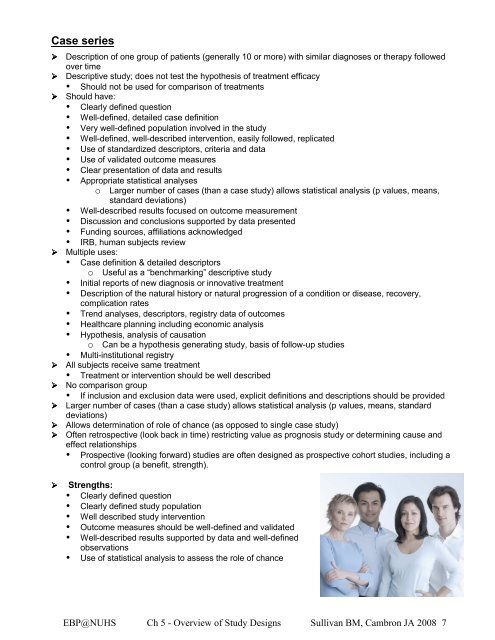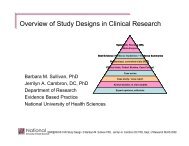Appraising the Literature Overview of Study Designs
Appraising the Literature Overview of Study Designs
Appraising the Literature Overview of Study Designs
Create successful ePaper yourself
Turn your PDF publications into a flip-book with our unique Google optimized e-Paper software.
Case series<br />
Description <strong>of</strong> one group <strong>of</strong> patients (generally 10 or more) with similar diagnoses or <strong>the</strong>rapy followed<br />
over time<br />
Descriptive study; does not test <strong>the</strong> hypo<strong>the</strong>sis <strong>of</strong> treatment efficacy<br />
Should not be used for comparison <strong>of</strong> treatments<br />
Should have:<br />
Clearly defined question<br />
Well-defined, detailed case definition<br />
Very well-defined population involved in <strong>the</strong> study<br />
Well-defined, well-described intervention, easily followed, replicated<br />
Use <strong>of</strong> standardized descriptors, criteria and data<br />
Use <strong>of</strong> validated outcome measures<br />
<br />
<br />
Clear presentation <strong>of</strong> data and results<br />
Appropriate statistical analyses<br />
o Larger number <strong>of</strong> cases (than a case study) allows statistical analysis (p values, means,<br />
standard deviations)<br />
Well-described results focused on outcome measurement<br />
Discussion and conclusions supported by data presented<br />
Funding sources, affiliations acknowledged<br />
IRB, human subjects review<br />
Multiple uses:<br />
Case definition & detailed descriptors<br />
o Useful as a “benchmarking” descriptive study<br />
Initial reports <strong>of</strong> new diagnosis or innovative treatment<br />
Description <strong>of</strong> <strong>the</strong> natural history or natural progression <strong>of</strong> a condition or disease, recovery,<br />
complication rates<br />
Trend analyses, descriptors, registry data <strong>of</strong> outcomes<br />
Healthcare planning including economic analysis<br />
Hypo<strong>the</strong>sis, analysis <strong>of</strong> causation<br />
o Can be a hypo<strong>the</strong>sis generating study, basis <strong>of</strong> follow-up studies<br />
Multi-institutional registry<br />
All subjects receive same treatment<br />
Treatment or intervention should be well described<br />
No comparison group<br />
If inclusion and exclusion data were used, explicit definitions and descriptions should be provided<br />
Larger number <strong>of</strong> cases (than a case study) allows statistical analysis (p values, means, standard<br />
deviations)<br />
Allows determination <strong>of</strong> role <strong>of</strong> chance (as opposed to single case study)<br />
Often retrospective (look back in time) restricting value as prognosis study or determining cause and<br />
effect relationships<br />
<br />
Prospective (looking forward) studies are <strong>of</strong>ten designed as prospective cohort studies, including a<br />
control group (a benefit, strength).<br />
<br />
Strengths:<br />
Clearly defined question<br />
Clearly defined study population<br />
Well described study intervention<br />
Outcome measures should be well-defined and validated<br />
Well-described results supported by data and well-defined<br />
observations<br />
Use <strong>of</strong> statistical analysis to assess <strong>the</strong> role <strong>of</strong> chance<br />
EBP@NUHS Ch 5 - <strong>Overview</strong> <strong>of</strong> <strong>Study</strong> <strong>Designs</strong> Sullivan BM, Cambron JA 2008 7





